A Novel Method to Build Real-World Drive Cycles from On-Road Data
Dheeraj Kapur and Pritesh Doshi, INA Bearings India Pvt. Ltd. (Schaeffler India)
A drive cycle is an engineering tool used for testing, validation, and certification of automobiles. It is a 2D plot of vehicle speed and time and is mainly used for fuel-economy, emission, and performance evaluation of automobiles. Their reproducible nature allows developers and manufacturers to run them on chassis-dynamometers, thereby achieving shorter development times and repeatable results. Today, drive cycles are becoming part of the development cycles of components, subsystems, and complete systems. They can be categorized into legislative drive cycles and real-world/custom drive cycles. The need for custom or real-world drive cycles arises from the fact that the drive scenarios tested by legislative cycles are not a fair representation of the drive scenarios encountered by an automobile in real driving conditions. While the results obtained from testing a vehicle using legislative cycles are widely accepted, they are, however, rarely encountered in real-world driving. Thus, to truly understand the benefits offered by any design or engineering change, it would be prudent to test the vehicle for real-world driving scenarios. It is not always possible to test a change by running the vehicle on the roads in real traffic conditions as it is time-consuming, expensive, and risky (a test-vehicle may not have all the necessary safety systems in place to make it fit for driving on roads). A real-world drive cycle, created from data gathered by driving a vehicle in day-to-day traffic scenarios, can act as a worthy representation of real-world drive scenarios and can be used to test the likely impact of a change that a vehicle is being tested for.
This work presents a way to create real-world drive cycles using data gathered by a test mule on the roads of Pune, India. It details the process starting from gathering of required data to creating the real-world drive cycle. Intermediate stages in this process involve analyzing the gathered data and determining the parameters that are important for creating a custom drive cycle. MATLAB® scripts were used to analyze the enormous sets of data gathered and to arrive at the final drive cycle. Various stages of data analysis and cycle development were automated using MATLAB scripts, reducing the cycle development time to about one-to-two weeks, which if done manually, could take months to complete. It is important to note that a drive cycle created using data gathered on the roads of a city is representative of the driving and traffic patterns of that particular city only; however, the approach presented in this work can be used to derive the drive cycle from data gathered in any city in the world.
Recorded: 26 Apr 2016





